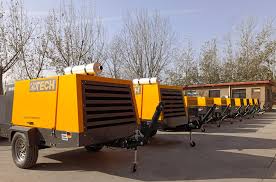Have you ever wondered how does a compressor work? These essential devices play a crucial role in numerous industries, from refrigeration to manufacturing. Compressors are the unseen force behind many of the technologies we rely on daily, ensuring everything from your refrigerator to industrial machinery operates smoothly. In this article, we’ll dive deep into the world of compressors, uncovering how they work and why they are so vital.
What is a Compressor?
A compressor is a mechanical device that increases the pressure of a gas by reducing its volume. This process, known as compression, is fundamental in various applications, including air conditioning, refrigeration, and industrial processes. Compressors come in different types, each suited to specific tasks and operating principles.
The Physics Behind Compressors
At the heart of every compressor is the principle of compression, which involves squeezing a gas to reduce its volume and increase its pressure. When the volume of a gas decreases, its molecules are forced closer together, resulting in higher pressure. This transformation of energy is essential for many applications, from powering pneumatic tools to cooling systems in your home.
Types of Compressors
Compressors can be broadly categorized into two main types: positive displacement compressors and dynamic compressors. Let’s explore each type in detail.
Positive Displacement Compressors
Reciprocating Compressors
These compressors work by using a piston within a cylinder to compress the gas. As the piston moves down, it draws gas into the cylinder. When the piston moves up, it compresses the gas, increasing its pressure before discharging it. Reciprocating compressors are commonly used in applications requiring high pressure.
Rotary Screw Compressors
In rotary screw compressors, two helical screws rotate to compress the gas. As the screws turn, the gas is trapped between the screws and the casing, gradually reducing its volume and increasing its pressure. These compressors are known for their efficiency and are widely used in industrial applications.
Dynamic Compressors
Centrifugal Compressors
Centrifugal compressors use a rotating impeller to accelerate the gas outward towards a diffuser, where the kinetic energy is converted into pressure. These compressors are typically used for applications requiring large volumes of gas at moderate pressures, such as HVAC systems.
Axial Compressors
Axial compressors work by compressing the gas through a series of rotating and stationary blades, arranged in stages. Each stage increases the pressure incrementally. These compressors are commonly used in jet engines and power plants due to their ability to handle high flow rates.
Components of a Compressor
Understanding how a compressor works requires a look at its key components:
- Compression Element: This is the part of the compressor that actually compresses the gas. It can be a piston, screw, impeller, or blade, depending on the type of compressor.
- Motor: The motor powers the compression element. It can be electric, diesel, or gasoline-powered.
- Control System: This regulates the operation of the compressor, ensuring it runs efficiently and safely.
- Lubrication System: Essential for reducing friction and wear on moving parts, extending the compressor’s lifespan.
How Does a Reciprocating Compressor Work?
In a reciprocating compressor, the piston moves down to draw gas into the cylinder through an intake valve. When the piston moves up, it compresses the gas, increasing its pressure. The compressed gas is then discharged through an outlet valve. This cycle repeats continuously, providing a steady flow of compressed gas.
How Does a Rotary Screw Compressor Work?
Rotary screw compressors use two meshing helical screws to compress the gas. As the screws rotate, gas is drawn in, trapped between the screws, and then compressed as the screws continue to turn. This type of compressor is known for its continuous operation and ability to handle large volumes of gas.
How Does a Centrifugal Compressor Work?
Centrifugal compressors use a high-speed rotating impeller to impart kinetic energy to the gas. The gas is then directed through a diffuser, where the kinetic energy is converted into pressure. This method is efficient for compressing large volumes of gas at moderate pressures.
How Does an Axial Compressor Work?
Axial compressors compress gas through multiple stages of rotating and stationary blades. The rotating blades accelerate the gas, while the stationary blades convert this kinetic energy into pressure. Each stage incrementally increases the gas pressure, making axial compressors ideal for high-flow applications.
Applications of Compressors
Compressors are incredibly versatile and find applications in various fields:
- Industrial Applications: Used in manufacturing processes, chemical plants, and oil refineries.
- Commercial Applications: Essential for HVAC systems, refrigeration, and pneumatic tools.
- Residential Applications: Found in home refrigerators, air conditioners, and heat pumps.
Advantages of Using Compressors
The benefits of compressors are numerous:
- Efficiency: Compressors can quickly and effectively increase gas pressure, making processes faster.
- Versatility: Suitable for a wide range of applications, from small-scale residential use to large industrial operations.
- Cost-effectiveness: Compressors can improve energy efficiency and reduce operational costs.
Challenges and Limitations
Despite their advantages, compressors come with some challenges:
- Maintenance Requirements: Regular maintenance is essential to ensure longevity and efficiency.
- Energy Consumption: Compressors can be energy-intensive, impacting operational costs.
- Noise and Environmental Impact: Compressors can be noisy and may have environmental impacts if not properly managed.
Maintenance Tips for Compressors
To keep compressors running smoothly, follow these maintenance tips:
- Regular Inspections: Regularly check for wear and tear, leaks, and other potential issues.
- Lubrication and Cooling: Ensure that the compressor is properly lubricated and cooled to prevent overheating and reduce friction.
- Replacing Worn Parts: Timely replacement of worn-out parts can prevent breakdowns and extend the compressor’s lifespan.
Innovations in Compressor Technology
Recent advancements in compressor technology focus on efficiency and sustainability:
- Energy-Efficient Models: New designs aim to reduce energy consumption and improve performance.
- Smart Compressors: Incorporating IoT technology for better monitoring and control.
- Eco-Friendly Refrigerants: Using environmentally friendly refrigerants to minimize impact on the ozone layer.
Conclusion
In summary, compressors are indispensable in many aspects of modern life, from industrial processes to household appliances. Understanding how they work and their various applications can help you appreciate their importance and ensure they are used and maintained effectively. With ongoing innovations, the future of compressor technology looks promising, with improvements in efficiency and environmental sustainability on the horizon.
FAQs
- What are the most common types of compressors?
- The most common types of compressors are reciprocating, rotary screw, centrifugal, and axial compressors, each with unique applications and operating principles.
- How often should a compressor be serviced?
- Compressors should typically be serviced every 3,000 to 4,000 hours of operation, but this can vary based on the type and usage. Always follow the manufacturer’s guidelines.
- What are the signs of a failing compressor?
- Signs of a failing compressor include unusual noises, reduced efficiency, frequent overheating, and increased vibration. Regular maintenance can help prevent these issues.
- Can compressors be used for both air and gas?
- Yes, compressors can be used to compress both air and various gases, depending on the design and application.
- What are some eco-friendly options for compressors?
- Eco-friendly options include compressors that use energy-efficient technologies and environmentally friendly refrigerants, helping to reduce their carbon footprint.






